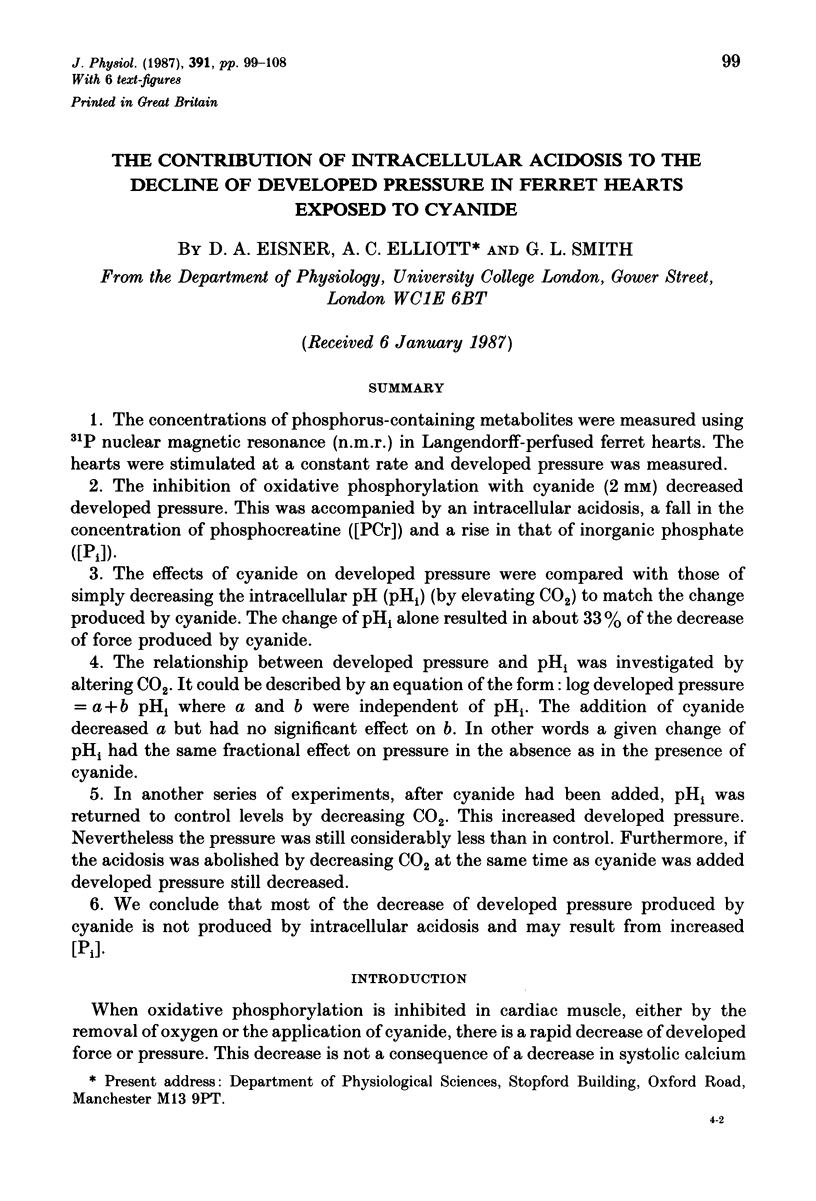Abstract
1. The concentrations of phosphorus-containing metabolites were measured using 31P nuclear magnetic resonance (n.m.r.) in Langendorff-perfused ferret hearts. The hearts were stimulated at a constant rate and developed pressure was measured. 2. The inhibition of oxidative phosphorylation with cyanide (2 mM) decreased developed pressure. This was accompanied by an intracellular acidosis, a fall in the concentration of phosphocreatine ([PCr]) and a rise in that of inorganic phosphate ([Pi]). 3. The effects of cyanide on developed pressure were compared with those of simply decreasing the intracellular pH (pHi) (by elevating CO2) to match the change produced by cyanide. The change of pHi alone resulted in about 33% of the decrease of force produced by cyanide. 4. The relationship between developed pressure and pHi was investigated by altering CO2. It could be described by an equation of the form:log developed pressure = a + b pHi where a and b were independent of pHi. The addition of cyanide decreased a but had no significant effect on b. In other words a given change of pHi had the same fractional effect on pressure in the absence as in the presence of cyanide. 5. In another series of experiments, after cyanide had been added, pHi was returned to control levels by decreasing CO2. This increased developed pressure. Nevertheless the pressure was still considerably less than in control. Furthermore, if the acidosis was abolished by decreasing CO2 at the same time as cyanide was added developed pressure still decreased. 6. We conclude that most of the decrease of developed pressure produced by cyanide is not produced by intracellular acidosis and may result from increased [Pi].
Full text
PDF









Selected References
These references are in PubMed. This may not be the complete list of references from this article.
- Allen D. G., Eisner D. A., Morris P. G., Pirolo J. S., Smith G. L. Metabolic consequences of increasing intracellular calcium and force production in perfused ferret hearts. J Physiol. 1986 Jul;376:121–141. doi: 10.1113/jphysiol.1986.sp016145. [DOI] [PMC free article] [PubMed] [Google Scholar]
- Allen D. G., Morris P. G., Orchard C. H., Pirolo J. S. A nuclear magnetic resonance study of metabolism in the ferret heart during hypoxia and inhibition of glycolysis. J Physiol. 1985 Apr;361:185–204. doi: 10.1113/jphysiol.1985.sp015640. [DOI] [PMC free article] [PubMed] [Google Scholar]
- Allen D. G., Orchard C. H. Intracellular calcium concentration during hypoxia and metabolic inhibition in mammalian ventricular muscle. J Physiol. 1983 Jun;339:107–122. doi: 10.1113/jphysiol.1983.sp014706. [DOI] [PMC free article] [PubMed] [Google Scholar]
- Bailey I. A., Williams S. R., Radda G. K., Gadian D. G. Activity of phosphorylase in total global ischaemia in the rat heart. A phosphorus-31 nuclear-magnetic-resonance study. Biochem J. 1981 Apr 15;196(1):171–178. doi: 10.1042/bj1960171. [DOI] [PMC free article] [PubMed] [Google Scholar]
- Dawson M. J., Gadian D. G., Wilkie D. R. Contraction and recovery of living muscles studies by 31P nuclear magnetic resonance. J Physiol. 1977 Jun;267(3):703–735. doi: 10.1113/jphysiol.1977.sp011835. [DOI] [PMC free article] [PubMed] [Google Scholar]
- Ellis D., Thomas R. C. Direct measurement of the intracellular pH of mammalian cardiac muscle. J Physiol. 1976 Nov;262(3):755–771. doi: 10.1113/jphysiol.1976.sp011619. [DOI] [PMC free article] [PubMed] [Google Scholar]
- Fabiato A., Fabiato F. Effects of pH on the myofilaments and the sarcoplasmic reticulum of skinned cells from cardiace and skeletal muscles. J Physiol. 1978 Mar;276:233–255. doi: 10.1113/jphysiol.1978.sp012231. [DOI] [PMC free article] [PubMed] [Google Scholar]
- Jacobus W. E., Pores I. H., Lucas S. K., Weisfeldt M. L., Flaherty J. T. Intracellular acidosis and contractility in the normal and ischemic heart as examined by 31P NMR. J Mol Cell Cardiol. 1982 Sep;14 (Suppl 3):13–20. doi: 10.1016/0022-2828(82)90124-9. [DOI] [PubMed] [Google Scholar]
- Katz A. M., Hecht H. H. Editorial: the early "pump" failure of the ischemic heart. Am J Med. 1969 Oct;47(4):497–502. doi: 10.1016/0002-9343(69)90180-6. [DOI] [PubMed] [Google Scholar]
- Kentish J. C. The effects of inorganic phosphate and creatine phosphate on force production in skinned muscles from rat ventricle. J Physiol. 1986 Jan;370:585–604. doi: 10.1113/jphysiol.1986.sp015952. [DOI] [PMC free article] [PubMed] [Google Scholar]
- Kusuoka H., Weisfeldt M. L., Zweier J. L., Jacobus W. E., Marban E. Mechanism of early contractile failure during hypoxia in intact ferret heart: evidence for modulation of maximal Ca2+-activated force by inorganic phosphate. Circ Res. 1986 Sep;59(3):270–282. doi: 10.1161/01.res.59.3.270. [DOI] [PubMed] [Google Scholar]


